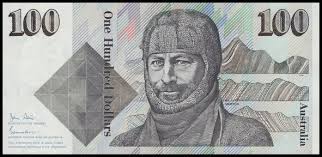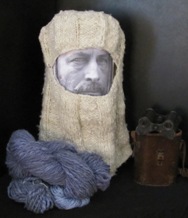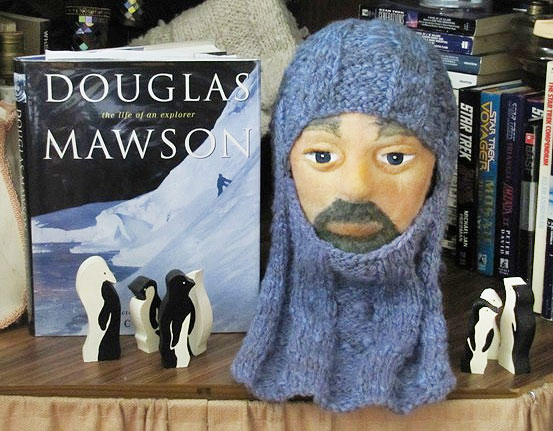The Balaclava
“Always do a practice knit!”

How many time have I heard these words? I’d hate to count! This time it would be important, and had to be right, so — — I did! Especially when the pattern is not as you expected. The famous Mawson balaclava, the one on the $100 note, does not appear in the 1910 pattern book that I have on my shelf. So, what to do?
The Mawson family kindly provided a colour photo of the garment, and to my surprise, the balaclava is blue in real life, and not that horrible SEPIA. It also has two tones of the blue which appears in a chequerboard effect. So using the photo as a guide, I devised a pattern to match the real balaclava.
Using 6mm needles and some spare white yarn of similar diameter to the Antarctic Yarn, I cast on the required number of stitches, as shown in the photo, and proceeded to count my rows to the shoulder split…. There did not seem to be any seam in the garment, and analysis showed that it was all one piece, so that is how it had to be done. The result was pleasing, but HUGE! Sir Douglas would have had to wear several beenies underneath it!
Knitting with handspun is a bit different from using commercially spun yarn. The inconsistent nature of handspun means that rather than counting stitches (as in commercial patterns) the knitter must work to a DIMENSION instead, by casting on the amount of stitches that will give the correct overall size. Adjusting the size of needles may also be necessary.
So, starting again, this time with different needles and estimating the correct amount of yarn needed, and taking a bit of “Poetic Licence”, the pattern was adjusted for BEST FIT and the knitting began again, at a fairly quick pace.
 The printed black and white photo of Sir Douglas Mawson’s face looking out from the white practice garment distracted me each time I passed my living room. Staring out from the Antarctic section of my overfull bookcase, Sir Douglas seemed to disappear under the knitted opening for his face. The redesigned blue replica, was much more suitable!
The printed black and white photo of Sir Douglas Mawson’s face looking out from the white practice garment distracted me each time I passed my living room. Staring out from the Antarctic section of my overfull bookcase, Sir Douglas seemed to disappear under the knitted opening for his face. The redesigned blue replica, was much more suitable!
Taking the balaclava to the marketplace, the knitting was completed at Boronia Mall in Melbourne’s Eastern Suburbs.There are a lot of people out there who are yet to learn of Sir Douglas Mawson and the work of the AAE. They have no idea where the Huts are and why they should be preserved. Hopefully, after that day, people have been inspired to learn for themselves.
How to display the balaclava for best sale? A felted head would show off, in very classy way, not only the garment, but also the crafting skills of felting. Long time fellow crafter and (sometimes) spinner Carolyn Rogers from Ripples on the Pond is a felting expert and Textile designer who is very interested in history and in a challenge. She embraced the idea of creating a head for the balaclava and in an afternoon of learning and experimenting, a model ‘Sir Douglas’ was formed! The beard and moustache are felted in to the main model, but the lovely blue eyes, which are purposely and effectively made to look tired and stressed, were done separately –. as if Sir Douglas had just returned from his ordeal. They really do add that extra presence.

